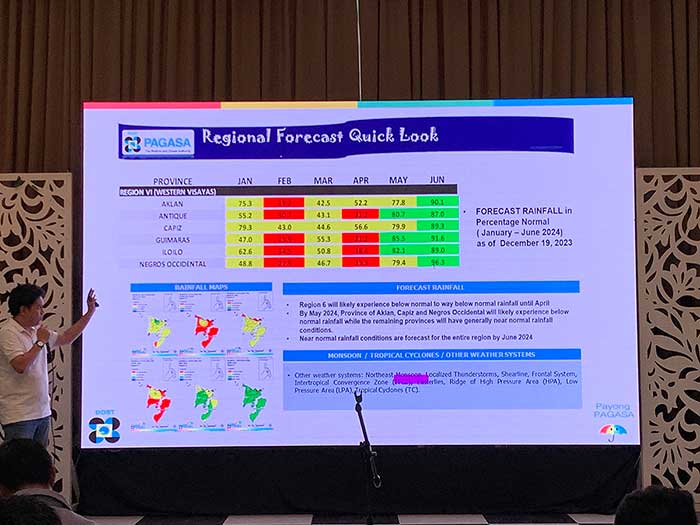
By Rjay Zuriaga Castor
Some provinces in Western Visayas will likely experience the most severe effects of a stronger El Niño phenomenon between the months of January to April next year, the Philippine Atmospheric, Geophysical and Astronomical Services Administration (Pagasa) said.
“Region 6 will likely experience below normal (yellow) to way below normal (red) rainfall until April,” said Engr. Ferdinand Rubin, Weather Specialist I of Pagasa Iloilo.
Rubin reported the forecast rainfall during the Iloilo Provincial Disaster Risk Reduction and Management Council meeting on Tuesday, December 19.
The state weather bureau warned of possible drought conditions for entire provinces of Western Visayas by the end of April.
Pagasa forecast showed that the crucial months are expected in February and April as with a high probability of “way below normal” rainfall conditions in most parts of the region.
According to Pagasa, a way below normal means less than or at least 40 percent chances of rainfall; 41 to 80 percent for below normal; 81 to 120 percent for near normal; and greater than 120 percent chances of rainfall for above normal.
Rubin said that by May 2024, the province of Aklan, Capiz and Negros Occidental will likely experience below normal rainfall while the remaining provinces will have generally near normal rainfall conditions.
“Near normal rainfall conditions are forecast for the entire region by June 2024,” the Pagasa added.
Despite the region experiencing the effects of El Niño during these months, the Pagasa said the region will still likely experience other weather systems such as northeast monsoon, localized thunderstorms, shearline, frontal system, low pressure area, among others.
The state weather bureau furthered that two to five tropical cyclones are expected to enter the country from January to June.
“Based on our historical data, the country records much less occurrence or development of typhoons in the Philippine Area of Responsibility during these months,” Rubin explained.
The weather specialist further urged the local government to prepare mitigation measures to combat the potential effects of El Niño.
“We need to put up preparedness measure as early as now in order to combat this possible effects, especially with the projection of a strong El Niño persisting at first quarter sang 2024,” he said.
Pagasa added that below average to warmer than average surface air temperatures are expected throughout the region during the forecast period.
Cold temperatures are expected to be experienced during the northeast monsoon season or amihan which usually lasts from October until February or March.




















